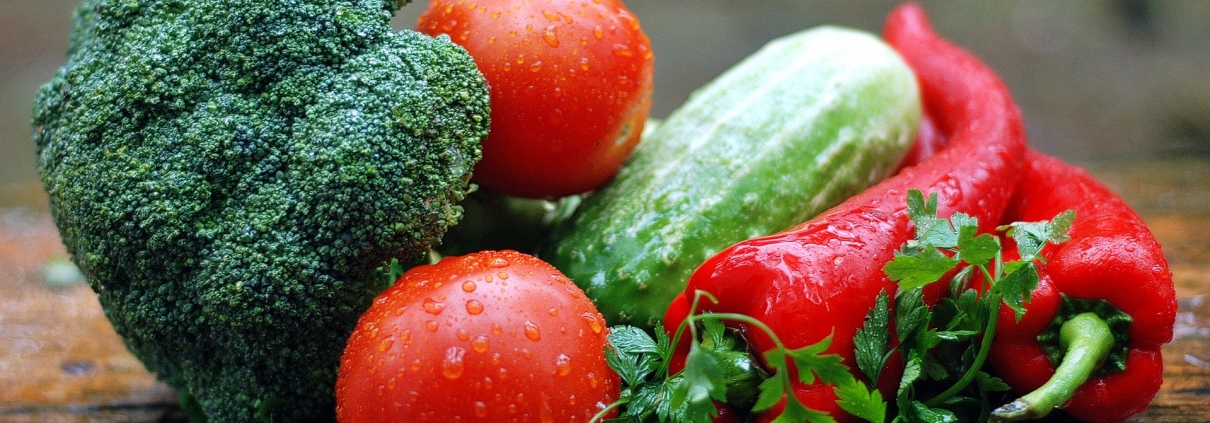Eat Right, Bite by Bite
By Cristina McMullen, ND, Certified Wellness Coach
Did you know that March is National Nutrition Month? A whole month dedicated to nutrition! How cool is that? This awareness is so needed in our country, especially since about half of all American adults (117 million individuals) have one or more preventable chronic diseases, many of which are related to poor quality eating and physical inactivity. Yes, you read that right! Half of the adults in this country could have prevented a chronic illness if they ate better and moved around more! With that staggering statistic, we should dedicate a whole year to nutrition!
This year the slogan for National Nutrition Month is “eat right, bite by bite.” Sounds simple right? Well, not so much. This is where things actually can get pretty tricky. You see, the field of nutrition is forever evolving and changing. Because of this, there is now quite a bit of contradicting dietary advice out there that can make figuring out what is healthy seem impossible. Fat is bad for you; fat is amazing for you. Eat meat; don’t eat meat. Drink your milk; stay away from all dairy. Eat your vegetables, just not the nightshades and ones that contain lectins or oxalates. Oh wait, now all vegetables are bad and you should only eat meat. It’s honestly enough to make even the wisest of nutritionists feel like they are going crazy and leaves us even more confused about what it means to truly eat right.
I personally got really interested in the world of nutrition as a young teenager. Back then, it was the 90’s and it seemed like new dietary recommendations were coming out every single day. It was when the American Heart Association told us that dietary fat was a main contributor to heart disease and that we all needed to adhere to a low fat diet. Then the “got milk” campaign rolled in and showed celebrities smiling with milk mustaches in order to promote strong bones. Soy was even touted as the next miracle food for cancer prevention. I remember reading the South Beach Diet and comparing it to the Atkins Diet, which completely went against everything they said about heart health.
Fast forward 20 years and things are quite different in the nutrition world. Diets like keto, Whole 30, and paleo are all the rage and go very much against so much of the older dietary advice. Keto tells us the more fat the better, while Whole 30 and paleo restrict any and all soy and dairy. The GAPS diet encourages you to eat yogurt, while the autoimmune paleo and low FODMAP require a Ph.D in order to figure out what you can and cannot eat!
In all of my years studying nutrition I have come to the conclusion that there honestly is not one solo diet out there that will be perfect for everyone! Our bodies are more complex than that, and a one-size-fits-all approach just doesn’t work! We each have different ancestral backgrounds, activity levels, and health concerns that should guide us in fine tuning our body’s nutritional needs. Our nutritional needs also change depending on which phase of life we are in.
There are, however, a few commonalities among many of the diets out there. Whether you are trying to eat keto, paleo, Whole 30, or any of the very popular diets out there right now, you are ultimately doing one thing. You are adhering to an anti-inflammatory diet.
What’s Inflammation Got to Do With It?
Think about all the names given to illnesses, both acute and chronic. There is sinusitis, bronchitis, arthritis, colitis, conjunctivitis, hepatitis, and myelitis to name a few. Notice how they all end in -itis? This means that they are all inflammatory diseases. Inflammation of the sinuses, inflammation of the bronchial tubes of the lungs, inflammation of the joints- you get the picture.
Inflammation in the body is a MAJOR contributor to just about every health ailment these days. More and more research suggests that anti-inflammatory diets are associated with lower risk of death at an early age. The Journal of Internal Medicine published results from a study in 2018 that showed individuals who stuck to a mostly anti-inflammatory diet for a period of 16 years had an 18% lower risk of all-cause mortality, 13% lower risk of dying from cancer, and 20% lower risk of dying from heart disease. So, while the internet can make figuring out what is truly healthy to eat seem very confusing, it really boils down to something very simple. Eating healthy bite by bite is simply eating the foods that do not promote inflammation in the body.
Anti-Inflammatory Diet
So what exactly are the key components of anti-inflammatory diets? What are the foods that need to be consumed and avoided? Here are a few components to a healthy, anti-inflammatory diet:
Eliminate Processed Foods
At the core of every single healthy diet is REAL food. Processed foods are just that – processed. Not only do they lack a lot of the nutritional value that we are supposed to be getting from the food we eat, but they contain a lot of fake, chemically made ingredients that are foreign to our bodies. And when our immune systems see something foreign, they trigger an inflammatory response. If you want to focus on real food, you want to shop the perimeter of the grocery store and avoid the aisles as much as possible. The aisles are stocked full of packages, boxes, and cans that have large lists of ingredients, many of which even I cannot pronounce while items in the outskirts of the store rarely even have an ingredient list. The less ingredients, the less processed the food items in your shopping cart will be.
Avoid Refined Sugars and High Fructose Corn Syrup
If you are staying away from processed foods, then you pretty much are already staying away from refined sugars and HFCS, but I want to drive home the dangers of sugar with some science. Sugar is 50% glucose and 50% fructose while high fructose corn syrup is 45% glucose and 55% fructose. There have been plenty of studies that show the inflammatory effects of both glucose and fructose. In one study, mice fed high sucrose diets developed breast cancer that spread to their lungs, partially because of the inflammatory response of sugar. In a randomized clinical trial where people drank regular soda, diet soda, milk, or water only those who consumed the regular soda has increased levels of uric acid, which drives inflammation and insulin resistance. Researchers have also noted that fructose causes inflammation within the endothelial cells that line your blood vessels, which is a risk factor for heart disease. It’s now wonder that the low fat diet isn’t helping to decrease our rates of heart disease in this country!
Stay Away From Trans Fats and Vegetable Oils
Artificial trans fats, also called hydrogenated fats, are hands down the worst type of fat for you. They are created by adding hydrogen to unsaturated fats, which are liquid, in order to make them solid at room temperature. Margarine and Crisco are two classic trans fats. Foods high in trans fat include french fries and other fast food, some microwave popcorn, packaged cakes and cookies, and some pastries. Consuming artificial trans fats is linked to high levels of inflammatory markers such as c-reactive protein (CRP). And like sugar, trans fats impair the function of the endothelial cells lining the arteries, making them another cause of heart disease.
Vegetable oils can be dangerous because they are high in omega-6 fatty acids. Now, we do need some omega 6 in our diets. The problem is that we are consuming way too much. During the 20% century, the consumption of vegetable oils has gone up 130%, mainly because we were told to switch from animal fat to vegetable fat for heart health. This throws off the balance among omega 3, 6, and 9 fatty acids that we need and promotes inflammation. In one study, rats fed a diet with an omega 6 to omega 3 ratio of 20:1 has much higher levels of inflammatory markers than those fed diets with ratios of 1:1 or 5:1.
Increase Your Consumption of Omega-3 Fatty Acids
Not only would increasing your consumption of omega-3’s help to balance out the abundance of omega-6’s in our diet, but omega-3 fatty acids in and of themselves are extremely anti-inflammatory. This is because they can reduce the production of molecules and substances linked to inflammation, such as inflammatory eicosanoids and cytokines. Wild caught fish is definitely highest in omega-3’s, but you can also get them by eating nuts and seeds like flax seeds, chia seeds, and walnuts. Another, lesser known source of omega-3 fatty acids is grass-fed, grass-finished red meat. Though originally touted as a food that causes heart disease, more in-depth research has shown that not all meat is created equal. Meat from cows fed a grain diet is much higher in omega-6 fatty acids while meat from cows fed on purely grass have much higher leves of the healthy omega-3 fatty acids.
Be Selective of Your Grains
Carbohydrates have developed quite a bad rap and seem to be the chosen enemy these days. But not all carbohydrates are created equal. Ultimately, it is the refined carbohydrates that pose a problem for us. These types of carbs are found in candy, bread, pasta, pastries, cereals, cookies, cakes, and sugary sodas. Research suggests that refined carbs may encourage the growth of inflammatory bacteria in our gut. This is because its lack of fiber starves the beneficial bacteria we need in our microbiome. On the flip side, whole grains like brown rice, quinoa, and oats are full of fiber and feed the healthy bacteria in our gut. The fiber also keeps us fuller longer and helps to prevent us from overeating.
Eat the Rainbow
No, I’m not talking about a bag of skittles! When I say eat the rainbow, I mean eat a wide variety of fruits and vegetables. These foods are full of phytonutrients and antioxidants that act as scavengers and help to clear out things called free radicals. Free radicals are in essence toxins that can lead to cell damage, which increases the risk of inflammation and ultimately lead to disease. The more colorful your plate, the wider variety of phytonutrients and larger capacity to neutralize free radicals.
So there you have it. My KISS method to diet and nutrition (Keep It Simple Sweetheart!). Follow all of these suggestions, and you are sure to be eating right bite by bite.


